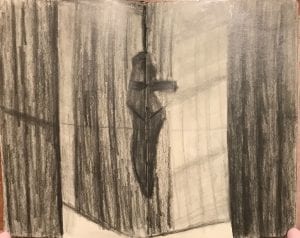I found the difference between the two religiously-significant buildings, Santiago Metropolitan Cathedral and the Benedictine Monastery, very interesting due to the fact that their styles and messages have such a stark contrast to each other. While they are relatively close in location, each in Santiago, they do not connect in any sense. The Santiago Metropolitan Cathedral boasts a large, grand facade in the bustling Plaza de Armas. The cathedral, which was rebuilt many times due to earthquakes, finally settled on a Neoclassical style. The three naves are huge and the crypt was slightly bigger and more well-lit than I was expecting it to be. The crypt did a nice job slowing down the distractions and overwhelming qualities of the large and highly-ornamented interior of the church. The simple and plain materials allowed all of the focus to draw on the hierarchy of the crypt— Jesus. The Cathedral, overall seemed to restrict the natural light, allowing it to come in from the stained glass windows and an oculus. It is such a large space that it makes you forget where you are. The multiple chapels provide various sacred areas along with the crypt.

The exterior of the Santiago Metropolitan Cathedral, with its context being located in Plaza de Armas.
This newer, simpler, more-modern Benedictine Monastery has a very different first impression than the Cathedral. The location, for one thing, provides a clue on what the intended effect of the building is. The Monastery is tucked away in the foothills of the Andes Mountains. It gives an amazing view of the surrounding mountains and towns below. It is not trying to fight for attention, as opposed to the Santiago Metropolitan Cathedral, which is competing with three other pieces of architecture around Plaza de Armas. The simple white exterior was beautiful against the blue sky, making any colors pop even more. The Monastery, while situated to admire the amazing view, does not have any windows to directly highlight the beauty. Instead, windows are tucked into the sides of the walls, at different angles, so they cannot be seen unless you’re looking for them. However, the building incorporates natural light in many ways: above and behind the alter, above the entrance, and behind the statue of Mary and Jesus. I found this use of light incredible since we went to the Monastery in the morning, which highlighted all the amazing features of the Monastery. The inside also was not ornamented like the Cathedral, which allowed you to focus on the statues, crosses, beautiful wood benches, and the glowing yellow light coming from within the chapel.
Personally, I found the slowed down pace and simple beauty of the Monastery more appealing because it allowed you to let go of any distractions or stress. The location and being able to see many mountains was quite amazing. The morning light also was a beautiful quality in and out of the space, shining over the white interior and exterior, showing the Monastery’s amazing qualities.

















